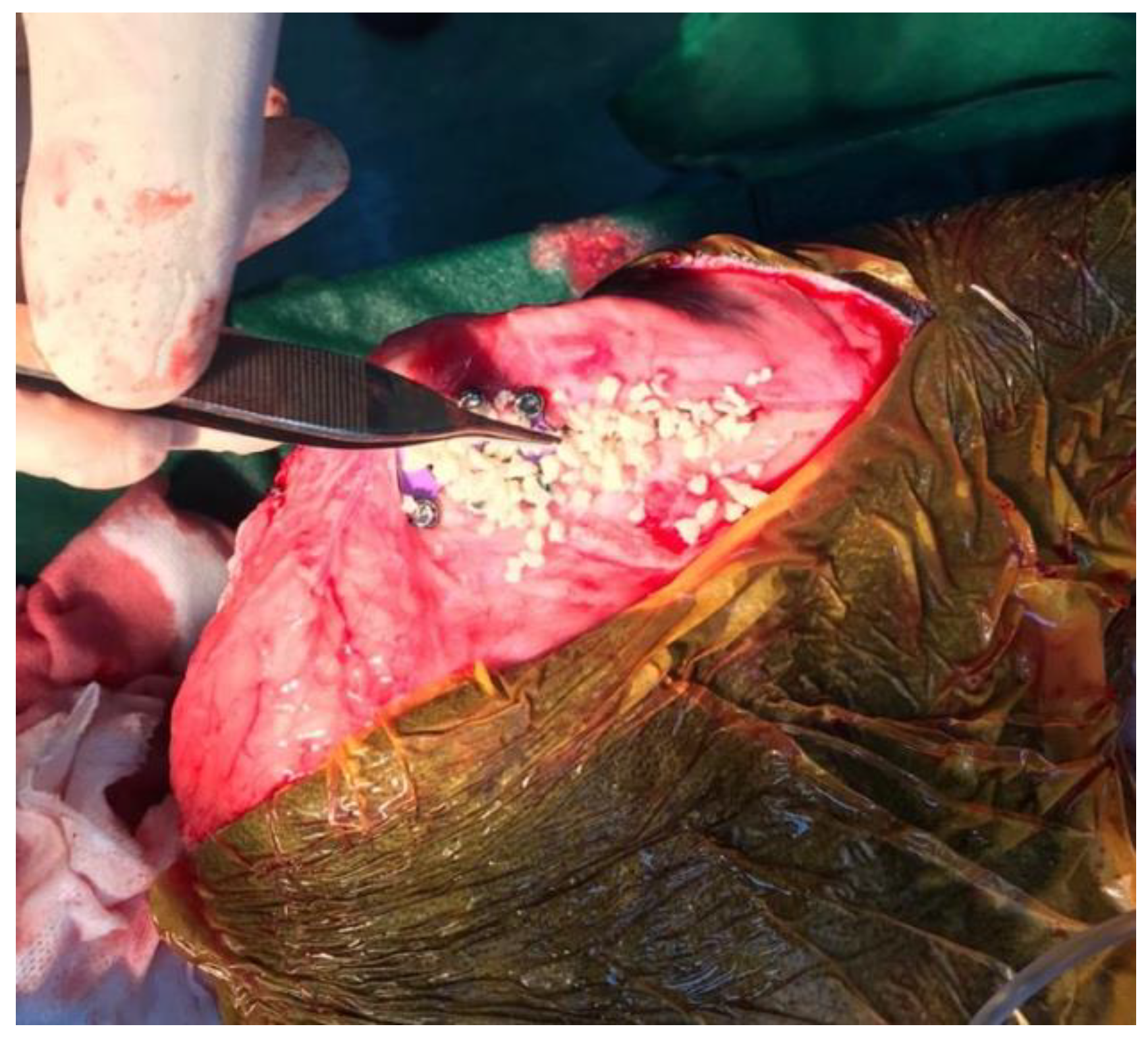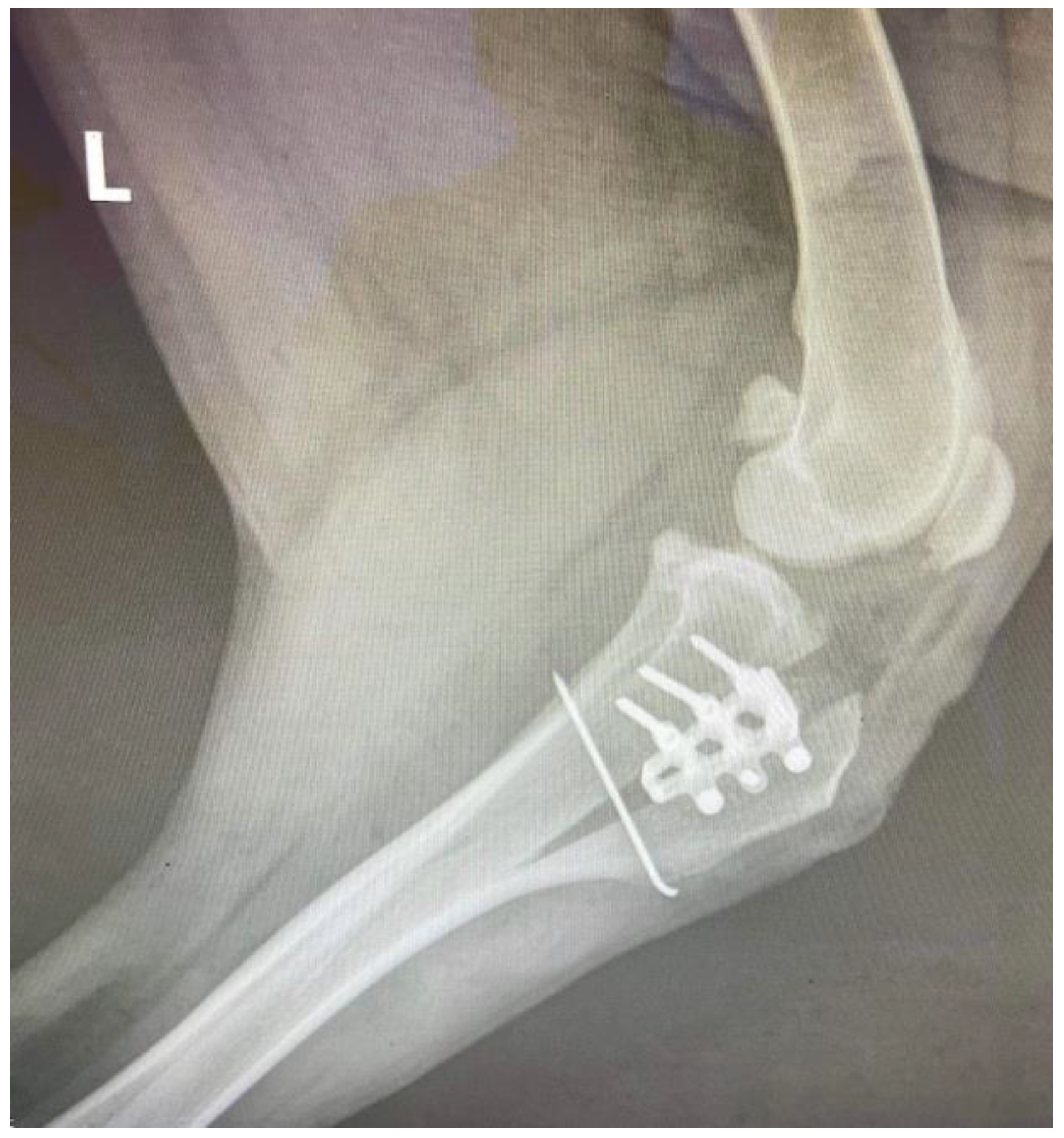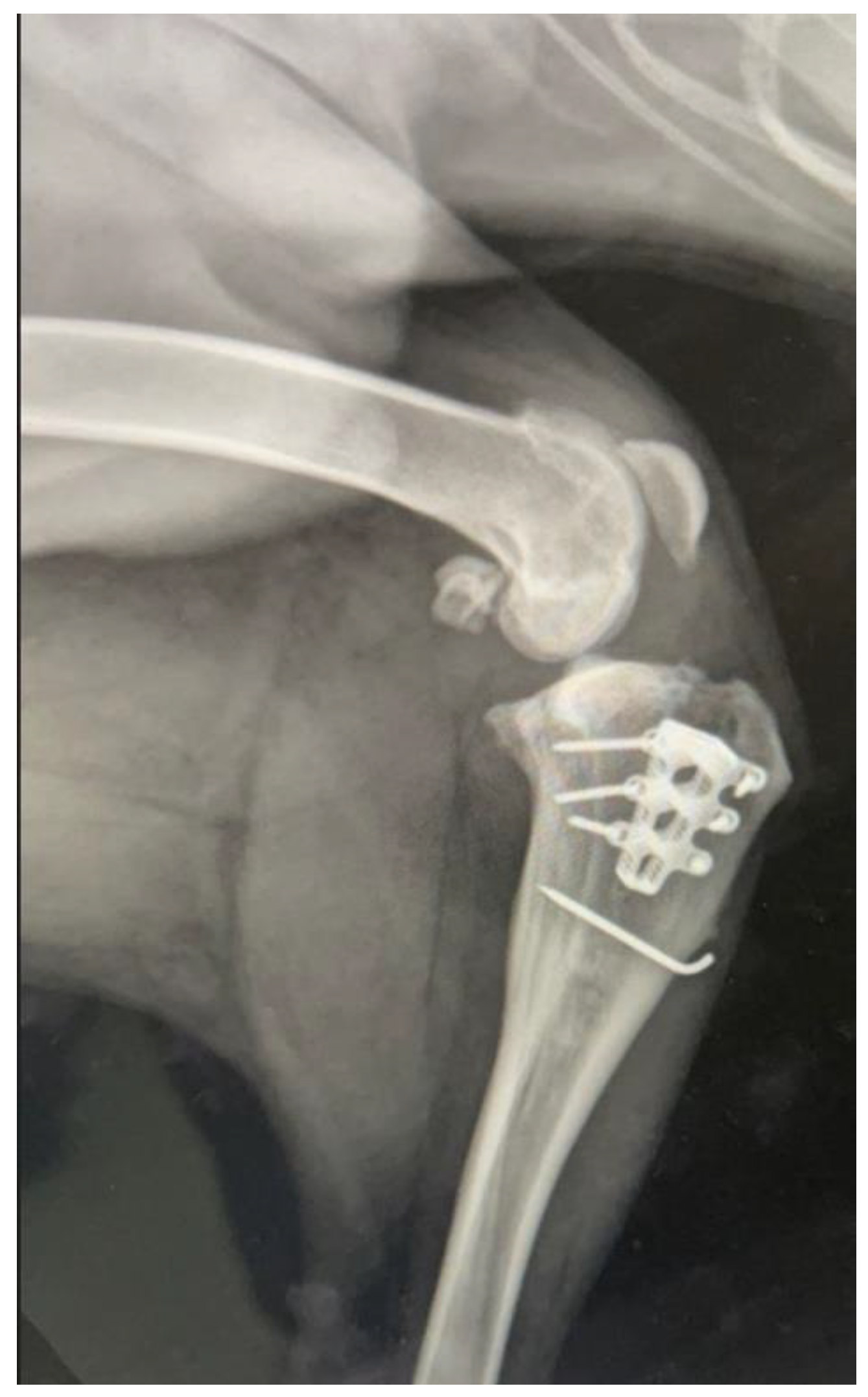Modified Tibial Tuberosity Advancement Rapid in a Dog with One Contralateral Amputated Limb
Abstract
:Simple Summary
Abstract
1. Introduction
2. Detailed Case Description
3. Discussion
4. Conclusions
Author Contributions
Funding
Institutional Review Board Statement
Informed Consent Statement
Data Availability Statement
Conflicts of Interest
References
- Witsberger, T.H.; Armando Villamil, J.; Schultz, L.G.; Hahn, A.W.; Cook, J.L. Prevalence of and risk factors for hip dysplasia and cranial cruciate ligament deficiency in dogs. J. Am. Vet. Med. Assoc. 2008, 232, 1818–1824. [Google Scholar] [CrossRef] [PubMed]
- Warnock, J.; Duerr, F. Stifle Region. In Canine Lameness, 1st ed.; Duerr, F., Ed.; John Wiley & Sons: Hoboken, NJ, USA, 2019; pp. 307–346. [Google Scholar]
- Boudrieau, R. Tibial plateau leveling osteotomy or tibial tuberosity advancement? Vet. Surg. 2009, 38, 1–22. [Google Scholar] [CrossRef] [PubMed]
- Montavon, P.M.; Damur, D.M.; Tepic, S. Advancement of the tibial tuberosity for the treatment of cranial cruciate deficient canine stifle. In Proceedings of the 1st World Orthopaedic Veterinary Congress, Munich, Germany, 5–8 September 2002; p. 152. [Google Scholar]
- Tepic, S.; Damur, D.M.; Montavon, P.M. Biomechanics of the stifle joint. In Proceedings of the 1st World Orthopaedic Veterinary Congress, Munich, Germany, 5–8 September 2002; pp. 189–190. [Google Scholar]
- Tepic, S.; Montavon, P.M. Is cranial tibial advancement relevant in the cruciate deficient stifle? In Proceedings of the 12th ESVOT Congress, Munich Germany, 10–12 September 2004; pp. 132–133. [Google Scholar]
- Christopher, S.A.; Beetem, J.; Cook, J.L. Comparison of long-term outcomes associated with three surgical techniques for treatment 848 of cranial cruciate ligament disease in dogs. Vet. Surg. 2013, 42, 329–334. [Google Scholar] [CrossRef] [PubMed]
- Murphy, S.; Chandler, J.C.; Brourman, J.D.; Bond, L. A randomized prospective comparison of dogs undergoing tibial tuberosity advancement or tibial plateau leveling osteotomy for cranial cruciate ligament rupture. In Proceedings of the 17th ESVOT Congress, Venice, Italy, 2–4 October 2014. [Google Scholar]
- Ramirez, J.; Barthélémy, N.; Noel, S.; Claeys, S.; Etchepareborde, S.; Farnir, F.; Balligand, M. Complications and outcome of a new modified Maquet technique for treatment of cranial cruciate ligament rupture in 82 dogs. Vet. Comp. Orthop. Traumatol. 2015, 28, 339–346. [Google Scholar] [CrossRef] [PubMed]
- Samoy, Y.; Verhoeven, G.; Bosmans, T.; Van der Vekens, E.; de Bakker, E.; Verleyen, P.; Van Ryssen, B. TTA Rapid: Description of the technique and short term clinical trial results of the first 50 Cases. Vet. Surg. 2015, 44, 474. [Google Scholar] [CrossRef] [PubMed]
- Hopmans, J. TTA-2 clinical experience. In Proceedings of the Kyon Symposium, Boston, MA, USA, 24–26 April 2015. [Google Scholar]
- Torrington, A. TTA-2 clinical trial study data. In Proceedings of the Kyon Symposium, Boston, MA, USA, 24–26 April 2015. [Google Scholar]
- Kowaleski, M.P.; Boudrieau, R.J.; Pozzi, A. Stifle Joint. In Veterinary Surgery: Small Animal, 1st ed.; Johnston, S.A., Tobias, K.M., Eds.; Elsevier: St. Louis, MO, USA, 2018; p. 1131. [Google Scholar]
- McCartney, W.; Ober, C.; Benito, M.; MacDonald, B. Comparison of tension band wiring and other tibial tuberosity advancement techniques for cranial cruciate ligament repair: An experimental study. Acta Vet. Scand. 2019, 61, 44. [Google Scholar] [CrossRef] [PubMed]
- Etchepareborde, S.; Brunel, L.; Bollen, G.; Balligand, M. Preliminary experience of a modified Maquet technique for repair of cranial cruciate ligament rupture in dogs. Vet. Comp. Orthop. Traumatol. 2011, 24, 223–227. [Google Scholar] [CrossRef] [PubMed]
- Butterworth, S.J.; Kydd, D.M. TTA-Rapid in the treatment of the canine cruciate deficient stifle: Short- and medium-term outcome. J. Small Anim. Pract. 2017, 58, 35–41. [Google Scholar] [CrossRef] [PubMed]
- Dyall, B.; Schmökel, H. Tibial tuberosity advancement in small-breed dogs using TTA Rapid implants: Complications and outcome. J. Small Anim. Pract. 2017, 58, 314–322. [Google Scholar] [CrossRef] [PubMed]
- Retallack, L.M.; Daye, R.M. A modified Maquet-tibial tuberosity advancement technique for treatment of canine cranial cruciate ligament disease: Short term outcome and complications. Vet. Surg. 2018, 47, 44–51. [Google Scholar] [CrossRef] [PubMed] [Green Version]
- Etchepareborde, S.; Balligand, M. Adaptation de la Procedure de Maquet pour le Traitement Chirurgical de la Rupture du Ligament croIsé Cranial chez le Chien. Ph.D. Thesis, Université de Liege, Liege, Belgium, 2013. [Google Scholar]
- Stein, S.; Schmoekel, H. Short-term and eight to 12 months results of a tibial tuberosity advancement as treatment of canine cranial cruciate ligament damage. J. Small Anim. Pract. 2008, 49, 398–404. [Google Scholar] [CrossRef] [PubMed]
- Guerrero, T.G.; Makara, M.A.; Katiofsky, K.; Fluckiger, M.A.; Morgan, J.P.; Haessig, M.; Montavon, P.M. Comparison of healing of the osteotomy gap after tibial tuberosity advancement with and without use of an autogenous cancellous bone graft. Vet. Surg. 2011, 40, 27–33. [Google Scholar] [CrossRef] [PubMed]
- Talaat, M.B.; Kowaleski, M.P.; Boudrieau, R.J. Combination tibial plateau leveling osteotomy and cranial closing wedge osteotomy of the tibia for the treatment of cranial cruciate ligament-deficient stifles with excessive tibial plateau angle. Vet. Surg. 2006, 35, 729–739. [Google Scholar] [CrossRef] [PubMed]
- Kuhn, K.; Ohlerth, S.; Makara, M.; Hässig, M.; Guerrero, T.G. Radiographic and ultrasonographic evaluation of the patellar ligament following tibial tuberosity advancement. Vet. Radiol. Ultrasound. 2011, 52, 466–471. [Google Scholar] [CrossRef] [PubMed]




Publisher’s Note: MDPI stays neutral with regard to jurisdictional claims in published maps and institutional affiliations. |
© 2022 by the authors. Licensee MDPI, Basel, Switzerland. This article is an open access article distributed under the terms and conditions of the Creative Commons Attribution (CC BY) license (https://creativecommons.org/licenses/by/4.0/).
Share and Cite
Ober, C.; Dragomir, M.; Aștilean, A.; McCartney, W.; Yiapanis, C.; Milgram, J. Modified Tibial Tuberosity Advancement Rapid in a Dog with One Contralateral Amputated Limb. Vet. Sci. 2022, 9, 476. https://doi.org/10.3390/vetsci9090476
Ober C, Dragomir M, Aștilean A, McCartney W, Yiapanis C, Milgram J. Modified Tibial Tuberosity Advancement Rapid in a Dog with One Contralateral Amputated Limb. Veterinary Sciences. 2022; 9(9):476. https://doi.org/10.3390/vetsci9090476
Chicago/Turabian StyleOber, Ciprian, Mădălina Dragomir, Andreea Aștilean, William McCartney, Christos Yiapanis, and Joshua Milgram. 2022. "Modified Tibial Tuberosity Advancement Rapid in a Dog with One Contralateral Amputated Limb" Veterinary Sciences 9, no. 9: 476. https://doi.org/10.3390/vetsci9090476
APA StyleOber, C., Dragomir, M., Aștilean, A., McCartney, W., Yiapanis, C., & Milgram, J. (2022). Modified Tibial Tuberosity Advancement Rapid in a Dog with One Contralateral Amputated Limb. Veterinary Sciences, 9(9), 476. https://doi.org/10.3390/vetsci9090476





